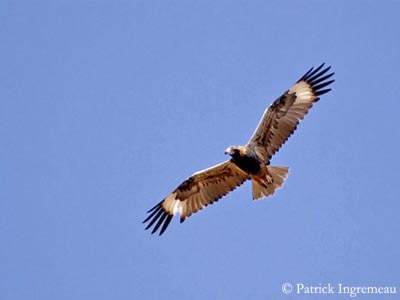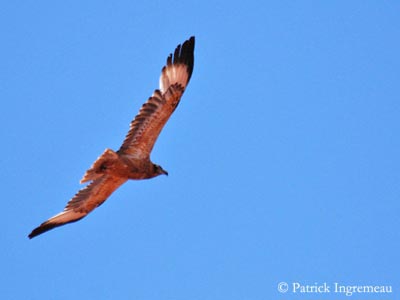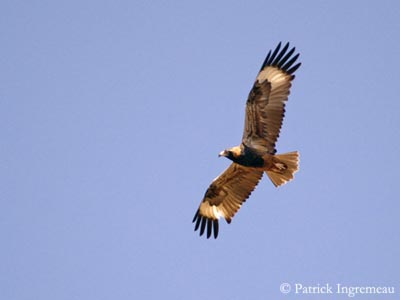
Both species have migratory and non migratory populations according to the range. The birds often move during the dry season and local movements are observed in winter. Any flocking or major concentration points, but the drought can force the birds to move. But they remain within the continent.
These two birds of prey are uncommon in their ranges. Declines occurred due to changes in the habitat, poisoning of carcasses and egg-collecting. However, they have adapted to vegetated outer areas of cities where they can find passerines for the Square-tailed Kite, whereas the Black-breasted Kite has benefited from introduced rabbits and stock carrion.
They are not globally threatened at this moment, but the breeding density is fairly low in both species and their populations are not very large.
Text by Nicole Bouglouan
Photographer:
Patrick Ingremeau
TAMANDUA
Sources:
HANDBOOK OF THE BIRDS OF THE WORLD Vol 2 by Josep del Hoyo-Andrew Elliot-Jordi Sargatal - Lynx Edicions - ISBN: 8487334156
Birds in backyards (Birds Australia and Australian Museum)
Wikipedia, the free encyclopaedia
BIRD: linking the biodiversity community
Cuckoo-hawks, Kites, Honey-buzzards
Third subgroup
3 - Kites endemic to Australasian regions
Genera Lophoictinia and Hamirostra
Both genera have traditionally been classified amongst the kites and related to the Old World genus Milvus, due to its superficial resemblance with them, and mainly in plumage. They are now considered part of old endemic Australasian group, and both are monotypic species.
The Square-tailed Kite (Lophoicyinia isura) could resemble a honey-buzzard at least by the head-shape. It has flat forehead and face, as the birds of this group. But the plumage is that of a kite, and especially a Black Kite (Milvus migrans).
This raptor is medium-sized with about 50-56 centimetres long and a weight of 500-680 grams. The body is slender with long wings. The difference is the square or slightly notched tail tip. Underparts are pale rufous with dark grey steaks on the breast. Upperparts are brown with paler areas on the upperwing-coverts. The flight feathers and the tail are dark brown with blackish bars. The underwing show rufous coverts and whitish barred blackish flight feathers. The undertail is whitish with indistinct dark bars.
The head shows whitish face and chin, and rufous, streaked dark grey crown, nape and hind neck.
The bill is blackish with pale grey cere. Eyes are pale yellowish-white. Legs and feet are pale yellowish to pinkish-grey.

Black-breasted Kite
Hamirostra melanosternon
The Black-breasted Kite (Hamirostra melanosternon) is almost similar to a small eagle with bulkier, longer (51-61 centimetres) and heavier body (1150 to 1450 grams) than previous. The plumage is darker and mainly black on the body. The rear crown, nape and hind neck are bright rufous and the face is black. Back and upperwing-coverts show rufous edges, whereas the flight feathers and the shorter, square-tipped tail are blackish-brown. On the black underparts, vent and undertail-coverts are rufous. The underwing shows white patches at base of black primary flight feathers as in Red Kite.
The heavy bill is horn-coloured with pale cere. The eyes are dark brown. Legs and feet are yellowish.
They frequent different type of habitats.
The Square-tailed Kite is found in open forest, woodland and edges, from sea-level up to 1000 metres of elevation. This species avoids arid and treeless areas, and does not frequent scrub, farmland and urban vicinity. It breeds in W, S and E Australia, and is found in north outside the breeding season.
The Square-tailed Kite feeds mainly on small birds, eggs and chicks such as passerines. It also catches insects, reptiles and tree-frogs, and rarely takes small mammals. It does not feed on carrion.
It forages while flying low and slowly above trees and shrub canopy, and hawks flying insects. It swoops down to snatch a prey from the foliage or catches it when starting to fly. It also removes or tears apart the nests. This raptor rarely alights on the ground.

Black-breasted Kite
Hamirostra melanosternon
The Black-breasted Kite prefers woodland and savannahs, or plains and deserts in N and C Australia. It can be seen from sea-level up to 500 metres of elevation. This one avoids forests.
It feeds on mammals, birds, reptiles and carrion, and can catch large insects. It usually prefers young mammals or birds, and also takes eggs and large lizards.
It forages by gliding and soaring at various heights, can also walk on the ground while searching for preys. It swoops down to catch preys from the trees, or on the ground. Thanks to its heavy bill, the Black-breasted Kite is able to break eggs of large ground-nesting birds such as Emu, and can even hurl stones at them while standing on the ground, as the Egyptian Vulture does too in its African range!

Black-breasted Kite
Hamirostra melanosternon
Both breed solitary, although sometimes, they can nests close to other raptors’ species. The nest is a platform made with sticks and lined with green leaves. It is placed in fork of tree (living or dead) between 8 and 22 metres above the ground, up to 34 metres in Square-tailed Kite.
In this species, the clutch usually contains 2-3 eggs and incubation lasts about 37-42 days. The young fledge 59 to 65 days after hatching, and depend on parents for one month more.
The Black-breasted Kite lays 1-2 eggs, and incubates during 36-40 days. The young fledge two months later, and depend on parents for food during at least two months more.

Black-breasted Kite
Hamirostra melanosternon